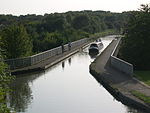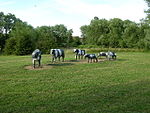Bradwell railway station
Beeching closures in EnglandDisused railway stations in BuckinghamshireFormer London and North Western Railway stationsPages with no open date in Infobox stationRailway stations in Great Britain closed in 1964 ... and 3 more
Railway stations in Great Britain opened in 1867Railway stations in Milton KeynesUse British English from December 2016

Bradwell railway station was a railway station on the Wolverton–Newport Pagnell line. It served both Bradwell and the new village of New Bradwell in Buckinghamshire. The station, which consisted of a brick-built station building, and single platform, opened to traffic in 1867. The last passenger train ran on 5 September 1964 but freight trains continued to pass through until 22 May 1967. The station building was demolished although the platform remains intact. The trackbed through the station has been converted into a shared path (footpath/cycle way), forming part of the Milton Keynes redway system.
Excerpt from the Wikipedia article Bradwell railway station (License: CC BY-SA 3.0, Authors, Images).Bradwell railway station
Railway Walk, Milton Keynes New Bradwell
Geographical coordinates (GPS) Address Nearby Places Show on map
Geographical coordinates (GPS)
| Latitude | Longitude |
|---|---|
| N 52.06372 ° | E -0.78648 ° |
Address
Railway Walk
Railway Walk
MK13 7AA Milton Keynes, New Bradwell
England, United Kingdom
Open on Google Maps










